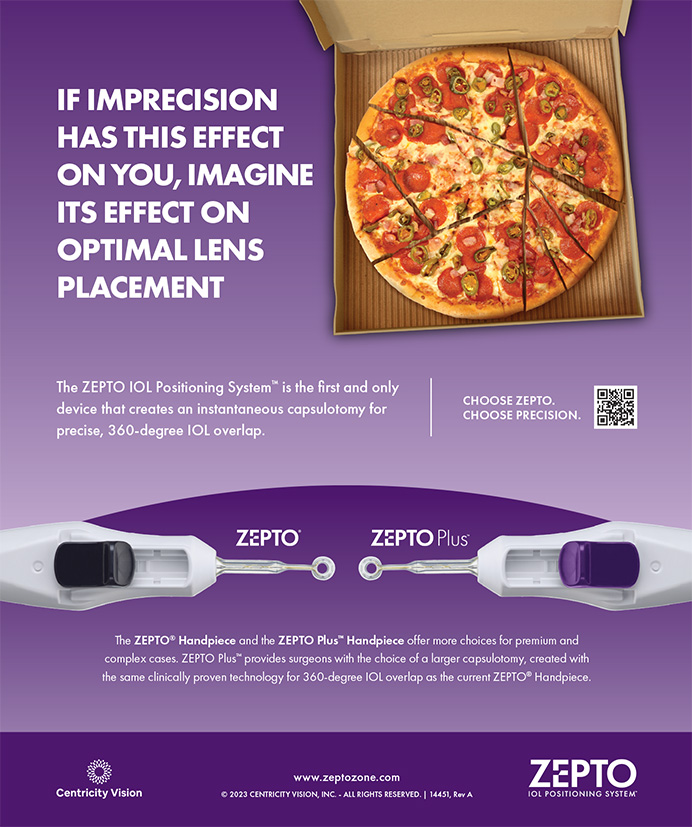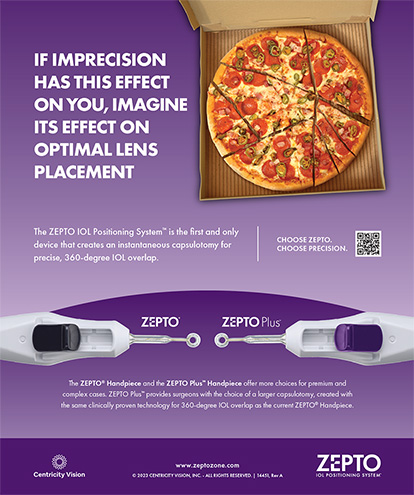Ophthalmic surgeons are concerned about the risk factors for the development of endophthalmitis. Although much of the focus on prevention has traditionally related to antibiotic prophylaxis, some investigators argue that sutureless clear corneal incisions may contribute to the development of this uncommon, yet devastating, complication of routine cataract surgery.1 They argue that there is a temporal correlation between an observed rise in the rate of endophthalmitis and the widespread use of sutureless clear corneal incisions.2
Other researchers report that there is no statistically significant increase in the rate of endophthalmitis during the same time period at their institutions as those of the aforementioned investigators. These reports fail to identify a statistical link between clear corneal incisions and endophthalmitis.3,4 Instead, these examiners suggest that the route of antibiotic administration may be one of the most important factors in preventing endophthalmitis.5,6
This article discusses the risk of endophthalmitis relative to types of incisions.
NO TWO INCISIONS ARE ALIKE
Differences in a Cut's Characteristics
One implied yet important assumption underlying the debate regarding clear corneal incisions is that they are all equal. Surgeons know, however, that there can be great variation in certain aspects of cataract incisions. Incisions can vary in length, location, angle, anterior and posterior thicknesses, shape, etc. There is also a considerable difference in the types of blades used, with many surgeons deferring to what works best for them.
Disparity in Wound Handling
Even if surgeons could consistently produce identical incisions, cataract surgery requires manipulation of the wound. This fact is obvious to a beginning surgeon, who is often uncomfortably surprised at the steep angle required for a phaco probe to reach the cataract in a highly myopic patient. Most of the studies that have implicated clear corneal incisions as a risk factor for endophthalmitis have not commented on these incisions' architecture at the end of each case.
Link Between Variability and Endophthalmitis?
Because there is heterogeneity in surgeons' clear corneal incisions, there may be a subgroup of wounds that increase the risk of endophthalmitis. If one could identify such a subgroup, one might better understand the variation in the rates of endophthalmitis across institutions and countries.
IDENTIFYING INCISIONS AT RISK
Inferotemporal
Increased scrutiny of clear corneal incisions has already allowed some surgeons to identify features that may influence the risk of endophthalmitis. Investigators from the Bascom Palmer Eye Institute in Miami observed that 86 of cases of endophthalmitis at their institution occurred in right eyes with incisions located inferotemporally.3 Perhaps this observation should encourage right-handed surgeons to avoid inferiorly located incisions by sitting superotemporally when operating on a right eye. Ophthalmologists performing glaucoma filtering procedures often take this step already.
Rectangular
Investigators suggest that the shape of the incision is key to its self-sealing.7 They argue that square incisions are superior to rectangular ones, because the former are more stable and therefore resistant to early postoperative hypotony and leakage. Perhaps surgeons should create square incisions.
Leaky
Although an incision prone to leakage is clearly undesirable in itself, a relationship between a leaking wound and endophthalmitis was highlighted in a 2005 cohort study from the University of Utah in Salt Lake City.8 Researchers found that a wound leak on the first postoperative day was associated with a 44-fold increased risk of endophthalmitis. Although the timing of the causative bacterial inoculum is not known in most cases of endophthalmitis, this correlation with a postoperative wound leak suggests that the bacteria gain entry during the early postoperative period in at least some cases.
NEW RISK
Clear Corneal Tongue
My colleagues and I recently described a flaw in the construction of clear corneal wounds that could be a cause of postoperative wound leak.9 We identified three patients who had undergone uncomplicated cataract procedures by two different surgeons. All three had leaking wounds in the postoperative period. A careful examination of the clear corneal incisions in each case revealed a common feature: the posterior lip of corneal tissue consisting of posterior stroma, Descemet's membrane, and endothelium was folded outward into the lumen of the incision. We described this everted tissue as a clear corneal tongue, and its presence could be confirmed by a slit-lamp examination and ultrasound biomicroscopy (Figure 1).
Although none of the patients in our study developed endophthalmitis, one patient had a positive Seidel sign 16 days postoperatively despite the placement of a suture at the time of surgery. This patient's clear corneal tongue was not only folded back into the wound, but the posterior tissue actually extruded from the eye and required a return to the OR to revise the wound (Figure 2). Another patient had a positive Seidel sign on postoperative day 9, suggesting that this mechanism of destabilizing the wound may lead to late leakage.
Two Categories
My colleagues and I described two types of clear corneal tongues. Type one consists of a simple folding of the free triangular flap frequently created by modern keratomes. Type two represents a lateral tear of the interior portion of the incision (Figure 3). The type-two tongue allows a larger piece of posterior tissue to evert toward the external eye, as occurred in our patient who had a wound leak despite the presence of a well-placed radial suture. We hypothesized that the type-two corneal tongue is created either by the side-cutting elements characteristic of some diamond keratomes or by the surgeon's manipulation of the wound when removing the cataract.
The folding of posterior tissue into the wound undermines the self-sealing properties of a clear corneal incision, because the tissue barrier prevents wound apposition at the internal entry site. Fluid can therefore enter rather than seal the wound via a valve-like mechanism. If endothelial pumping is a component in the closure of clear corneal incisions, it also would be compromised, because Descemet's membrane and the endothelium are inverted and folded into the wound itself. Repositioning the corneal tongue restores the normal anatomy that supports a valve-like, self-sealing wound.
CONCLUSION
I have observed clear corneal tongues intraoperatively for several years now. I stumbled upon the observation when I decided to stop performing stromal hydration of cataract incisions at the end of surgery. At that time, I began to notice that some wounds leaked at the end of surgery, whereas others did not. I realized that the clear corneal tongue was a key difference between wounds that leaked and those that did not. I then developed a technique for closing the wound that involves repositioning the corneal tongue and avoiding stromal hydration. Although this process adds some time to the end of the case, I feel more comfortable with a wound that I know is self-sealing without the temporary assistance of stromal hydration.
As investigators pay more attention to the issue of clear corneal incisions' architecture, I am hopeful that surgeons can continue to improve the incisions' creation and closure. If one can combine a sensible clear corneal incision with evidence-based antibiotic prophylaxis, I am confident that efficient, safe, high-quality cataract surgery will be ensured for patients now and in the future.
Ayman Naseri, MD, is Assistant Professor at the Department of Ophthalmology at the University of California, San Francisco, and Chief of the Department of Ophthalmology at the San Francisco VA Medical Center. Dr. Naseri may be reached at (415) 476-0678; ayman.naseri@va.gov.


